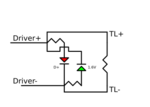Saltwater
Member level 3
Hi,
I have these SN75176 line drivers. And I was trying to see if I could hack some skew to the DC offset.
One circuit working on a testbench was the following circuit.

I have some questions tho.. Is this circuit any good for stability, "adding resistance and impedance down the line"?
Given it's just making square waves.
Regards,
I have these SN75176 line drivers. And I was trying to see if I could hack some skew to the DC offset.
One circuit working on a testbench was the following circuit.

I have some questions tho.. Is this circuit any good for stability, "adding resistance and impedance down the line"?
Given it's just making square waves.
Regards,
Last edited:
